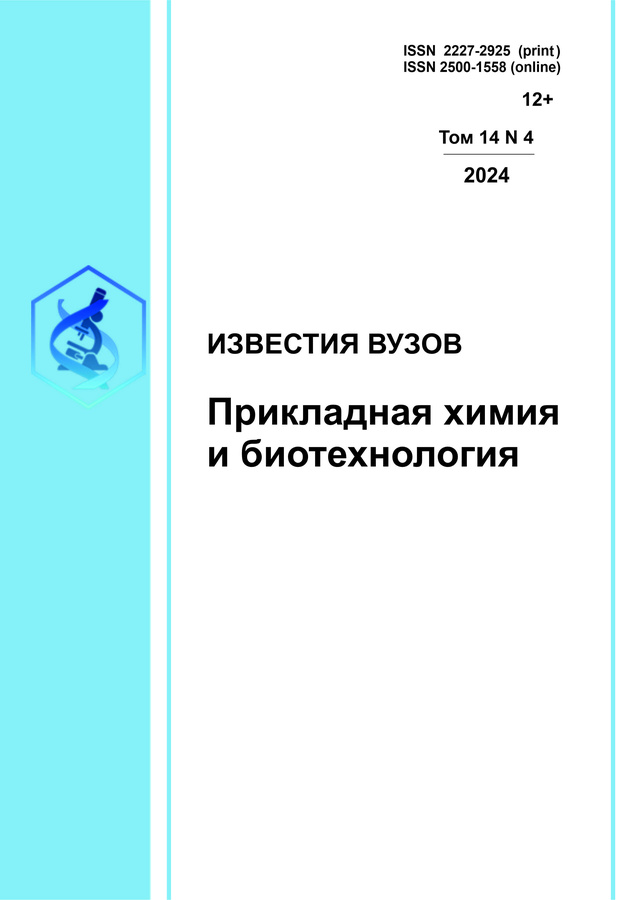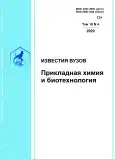Методика электрохимического биотестирования в применении к сравнительному анализу антибиотических свойств растительных экстрактов, получаемых с помощью сжиженного СО 2
- Авторы: Сибирцев В.С.1, Нечипоренко У.Ю.1, Кабанов В.Л.1, Буханцев О.В.1
-
Учреждения:
- Всероссийский научно-исследовательский институт пищевых добавок -филиал Федерального научного центра пищевых систем им. В.М. Горбатова, РАН
- Выпуск: Том 10, № 4 (2020)
- Страницы: 590-602
- Раздел: Физико-химическая биология
- URL: https://bakhtiniada.ru/2227-2925/article/view/299583
- DOI: https://doi.org/10.21285/2227-2925-2020-10-4-590-602
- ID: 299583
Цитировать
Полный текст
Аннотация
Об авторах
В. С. Сибирцев
Всероссийский научно-исследовательский институт пищевых добавок -филиал Федерального научного центра пищевых систем им. В.М. Горбатова, РАН
Email: vs1969r@mail.ru
У. Ю. Нечипоренко
Всероссийский научно-исследовательский институт пищевых добавок -филиал Федерального научного центра пищевых систем им. В.М. Горбатова, РАН
Email: unechiporenko@yandex.ru
В. Л. Кабанов
Всероссийский научно-исследовательский институт пищевых добавок -филиал Федерального научного центра пищевых систем им. В.М. Горбатова, РАН
Email: kabanof_v@yahoo.com
О. В. Буханцев
Всероссийский научно-исследовательский институт пищевых добавок -филиал Федерального научного центра пищевых систем им. В.М. Горбатова, РАН
Email: bukhantsev_ov@yandex.ru
Список литературы
- Sutherland J., Miles M., Hedderley D., Li J., Devoy S., Sutton K., Lauren D. In vitro effects of food extracts on selected probiotic and pathogenic bacteria // International Journal of Food Sciences and Nutrition. 2009. Vol. 60. issue 8. Р. 717-727. https://doi.org/10.3109/09637480802165650
- Das S., Anjeza C., Mandal S. Synergistic or additive antimicrobial activities of Indian spice and herbal extracts against pathogenic, probiotic and food-spoiler microorganisms // International Food Research Journal. 2012. Vol. 19. Issue 3. Р. 11851191.
- Al-Zubairi A. S., Al-Mamary M. A., Al-Ghasani E. The antibacterial, antifungal and antioxidant activities of essential oil from different aromatic plants // Global Advanced Research Journal of Medicine and Medical Sciences. 2017. Vol. 6. Issue 9. Р. 224233.
- Zhuravlev O.E., Voronchikhina L.I. Synthesis and antimicrobial activity of n-decylpyridinium salts with inorganic anions // Pharmaceutical Chemistry Journal. 2018. Vol. 52. Issue 4. P. 312-315. https://doi.org/10.1007/s11094-018-1813-6
- Luzhnova S.A., Tyrkov A.G., Gabitova N.M., Yurtaeva E.A. Synthesis and antimicrobial activity of 5-(arylmethylidene)-2,4,6-pyrimidine-2,4,6(1H,3H,5H)-triones // Pharmaceutical Chemistry Journal. 2018. Vol. 52. Issue 6. P. 506-509. https://doi.org/10.1007/s11094-018-1849-7
- Rodino S., Butu M. Herbal extracts - new trends in functional and medicinal beverages. In: Grumezescu A.M., Holban A.M. (ed.). Functional and Medicinal Beverages. Vol. 11: The Science of Beverages. Chapter 3. Academic Press. 2019. P. 73-108. https://doi.org/10.1016/B978-0-12-816397-9.00003-0
- Burt S. Essential oils: their antibacterial properties and potential applications in foods - a review // International Journal of Food Microbiology. 2004. Vol. 94. Issue 3. P. 223-253. https://doi.org/10.1016/j.ijfoodmicro.2004.03.022
- Bakkali F., Averbeck S., Averbeck D., Ida-omar M. Biological effects of essential oils - a review // Food and Chemical Toxicology. 2008. Vol. 46. Issue 2. Р. 446-475. https://doi.org/10.1016/j.fct.2007.09.106
- Tripathi A.K., Bhoyar P.K., Baheti J.R., Biyani D.M., Khalique M., Kothmire M.S., et al. Herbal antidiabetics: a review // International Journal of Research in Pharmaceutical Sciences. 2011. Vol. 2. Issue 1. Р. 30-37.
- Fatima A., Alok S., Agarwal P., Singh P.P., Verma A. Benefits of herbal extracts in cosmetics: a review // International Journal of Pharmaceutical Sciences and Research. 2013. Vol. 4. Issue 10. Р. 3746-3760. https://doi.org/10.13040/ijpsr.0975-8232.4(10).3746-60
- Alok S., Jain S.K., Verma A., Kumar M., Ma-hor A., Sabharwal M. Herbal antioxidant in clinical practice: a review // Asian Pacific Journal of Tropical Biomedicine. 2014. Vol. 4. Issue 1. P. 78-84. https://doi.org/10.1016/S2221-1691(14)60213-6
- Radice M., Manfredini S., Ziosi P., Dissette V., Buso P., Fallacara A., et al. Herbal extracts, lichens and biomolecules as natural photo-protection alternatives to synthetic UV filters. A systematic review // Fitoterapia. 2016. Vol. 114. Р. 144-162. https://doi.org/10.1016/j.fitote.2016.09.003
- Merghni A., Marzouki H., Hentati H., Aouni M., Mastouri M. Antibacterial and antibiofilm activities of Laurus nobilis L. essential oil against Staphylococcus aureus strains associated with oral infections // Current Research in Translational Medicine. 2016. Vol. 64. Issue 1. Р. 29-34. https://doi.org/10.1016/j.patbio.2015.10.003
- Fani M., Kohanteb J. In vitro antimicrobial activity of thymus vulgaris essential oil against major oral pathogens // Journal of Evidence-based Complementary & Alternative Medicine. 2017. Vol. 22. Issue 4. Р. 660-666. https://doi.org/10.1177/2156587217700772
- Kokina M.S., Frioui M., Shamtsyan M., Sibirtsev V.S., Krasnikova L.V., Konusova V.G., et al. Influence of pleurotus ostreatus в-glucans on the growth and activity of certain lactic acid bacteria // Scientific Study and Research: Chemistry and Chemical Engineering, Biotechnology, Food Industry. 2018. Vol. 19. Issue 4. Р. 465-471.
- Atares L., Chiralt A. Essential oils as additives in biodegradable films and coatings for active food packaging // Trends in Food Science & Technology. 2016. Vol. 48. P. 51-62. https://doi.org/10.1016/j.tifs.2015.12.001
- Ribeiro-Santos R., Andrade M., Melo N.R., Sanches-Silva A. Use of essential oils in active food packaging: Recent advances and future trends // Trends in Food Science & Technology. 2017. Vol. 61. P. 132-140. https://doi.org/10.1016/j.tifs.2016.11.021
- Ju J., Xie Y., Guo Y., Cheng Y., Qian H., Yao W. Application of edible coating with essential oil in food preservation // Critical Reviews in Food Science and Nutrition. 2019. Vol. 59. Issue 15. P. 2467-2480. https://doi.org/10.1080/10408398.2018.1456402
- Yuan G.-F., Chen X., Li D. Chitosan films and coatings containing essential oils: The antioxidant and antimicrobial activity, and application in food systems // Food Research International. 2016. Vol. 89. Part 1. P. 117-128. https://doi.org/10.1016/j.foodres.2016.10.004
- Donsi F., Ferrari G. Essential oil nanoemulsions as antimicrobial agents in food // Journal of Biotechnology. 2016. Vol. 233. P. 106-120. https://doi.org/10.1016/j.jbiotec.2016.07.005
- Pavela R., Benelli G. Essential Oils as Ecofriendly Biopesticides? Challenges and Constraints // Trends in Plant Science. 2016. Vol. 21. Issue 12. Р. 1000-1007. https://doi.org/10.1016/j.tplants.2016.10.005
- Rout P.K., Naik S.N., Rao Y.R. Subcritical CO2 extraction of floral fragrance from Quisqualis indica // Journal of Supercritical Fluids. 2008. Vol. 45. Issue 2. P. 200-205. https://doi.org/10.1016/j.supflu.2008.02.011
- Sahena F., Zaidul I.S.M., Jinap S., Karim A.A., Abbas K.A., Norulaini N.A.N., et al. Application of supercritical CO2 in lipid extraction - a review // Journal of Food Engineering. 2009. Vol. 95. Issue 2. P. 240-253. https://doi.org/10.1016/j.jfoodeng.2009.06.026
- Ibadullaeva G.S., Pichkhadze G.M., Usteno-va G.O., Dil’barkhanov R., Tikhonova S.A., Grud’-ko V.A., et al. Chemical composition of the CO2-extract of Acorus Calamus obtained under subcriti-cal conditions // Pharmaceutical Chemistry Journal. 2015. Vol. 49. Issue 6. Р. 388-392. https://doi.org/10.1007/s11094-015-1290-0
- Valle Jr.D.L., Cabrera E.C., Puzon J.J.M., Rivera W.L. Antimicrobial activities of methanol, ethanol and supercritical CO2 extracts of Philippine Piper betle L. on clinical isolates of gram positive and gram negative bacteria with transferable multiple drug resistance // PLoS ONE. 2016. Vol. 11. Issue 1. Article e0146349. https://doi.org/10.1371/journal.pone.0146349
- Lazarotto M., Valerio A., Boligon A., Tres M.V., Scapinello J., Dal Magro J., et al. Chemical composition and antibacterial activity of bergamot peel oil from supercritical CO2 and compressed propane extraction // Open Food Science Journal. 2018. Vol. 10. Issue 1. Р. 16-23. https://doi.org/10.2174/1874256401810010016
- Vieitez I., Maceiras L., Jachmanian I., Al-bores S. Antioxidant and antibacterial activity of different extracts from herbs obtained by maceration or supercritical technology // Journal of Supercritical Fluids. 2018. Vol. 133. Р. 58-64. https://doi.org/10.1016/j.supflu.2017.09.025
- Coelho J., Veiga J., Karmali A., Nicolai M., Pinto Reis C., Nobre B., et al. Supercritical CO2 extracts and volatile oil of basil (Ocimum basilicum L.) comparison with conventional methods // Separations. 2018. Vol. 5. Issue 2. Р. 21-33. https://doi.org/10.3390/separations5020021
- Sibirtsev V.S., Garabadzhiu A.V., Ivanov S.D. Spectral properties of bisbenzimidazole dyes upon interaction with DNA // Russian Journal of Bioorganic Chemistry. 1997. Vol. 23. Issue 12. P. 857-866.
- Иванов С.Д., Коваленко А.Л., Ковань-ко Е.Г., Ямшанов В.А., Акимов А.А., Забежинский М.А.. Применение циклоферона при экспериментальной лучевой терапии опухолей // Вопросы онкологии. 1999. Т. 45. N 3. С. 292-297.
- Sibirtsev V.S., Glibin E.N., Ivanov S.D. Variation of spectral properties of actinocin derivatives due to equilibrium transformations // Russian Journal of Organic Chemistry. 2000. Vol. 36. Issue 12. P. 1812-1818.
- Sibirtsev V.S., Garabadzhiu A.V., Ivanov S.D. Comparative study of DNA-specific dyes of the indole and benzimidazole series // Russian Journal of Organic Chemistry. 2001. Vol. 27. Issue 1. P. 5473. https://doi.org/10.1023/A:1009535320077
- Sibirtsev V.S., Tolmachev A.Yu., Suslov V.V., Garabadzhiu A.V., Traven' V.F. Dependence of fluorescence properties of compounds from psoralen, angelicin, and carbazole series on the character of their terminal substituents // Russian Journal of Organic Chemistry. 2003. Vol. 39. Issue 6. P. 881-889. https://doi.org/10.1023/B:RUJO.0000003169.96393.1d
- Sibirtsev V.S. Study of applicability of the bifunctional system “Ethidium bromide + Hoechst-33258” for DNA analysis // Biochemistry (Moscow). 2005. Vol. 70. Issue 4. P. 449-457. https://doi.org/10.1007/s10541-005-0136-x
- Sibirtsev V.S., Tolmachev A.Yu., Kovaleva M.V., Garabadzhiu A.V., Traven V.F. Spectral study of interactions of 4,8,4'-trimethylpsoralen and 4,4'-dimethylangelicin dyes with DNA // Biochemistry (Moscow). 2005. Vol. 70. Issue 7. P. 822-832. http://doi.org/10.1007/s10541-005-0190-4
- Sibirtsev V.S. Fluorescent DNA probes: study of mechanisms of changes in spectral properties and features of practical application // Biochemistry (Moscow). 2007. Vol. 72. Issue 8. P. 887-900. https://doi.org/10.1134/S0006297907080111
- Sibirtsev V.S., Garabadzhiu A.V. Spectral study of the interaction of DNA with benzothiazolyl-benz-a-chromene // Biochemistry (Moscow). 2007. Vol. 72. Issue 8. P. 901-909. https://doi.org/10.1134/S0006297907080123
- Sibirtsev V.S., Naumov I.A., Kuprina E.E., Olekhnovich R.O. Use of impedance biotesting to assess the actions of pharmaceutical compounds on the growth of microorganisms // Pharmaceutical Chemistry Journal. 2016. Vol. 50. Issue 7. P. 481485. https://doi.org/10.1007/s11094-016-1473-3
- Сибирцев В.С., Маслова А.Ю. Комплексное исследование динамики жизнедеятельности E. coli в присутствии ионов переходных металлов // Научно-технический вестник информационных технологий, механики и оптики. 2019. Т. 19. N 2. С. 236-241. https://doi.org/10.17586/2226-1494-2019-19-2-236-241
- Sibirtsev V.S., Uspenskaya M.V., Gara-badgiu A.V., Shvets V.I. An integrated method of instrumental microbiotesting of environmental safety of various products, wastes, and territories // Dokla-dy Biological Sciences. 2019. Vol. 485. Issue 1. P. 59-61. https://doi.org/10.1134/S001249661902011X
- Сибирцев В.С., Гарабаджиу А.В., Швец В.И. Новая методика комплексного фотофлуоресцентного микробиотестирования // Доклады Академии наук. 2019. Т. 489. N 6. С. 641-645. https://doi.org/10.31857/S0869-56524896641-645
- Johnson K.J. Numerical methods in chemistry. New York: Taylor & Francis, 1980. 503 p.
- Sibirtsev V.S. Analysis of benzopyrene deactivation mechanisms in rats // Bioche-mistry (Moscow). 2006. Vol. 71. Issue 1. P. 90-98. https://doi.org/10.1134/S0006297906010147
Дополнительные файлы










